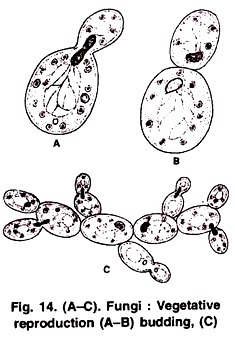ADVERTISEMENTS:
One of the main objectives of environmental biotechnology is the conservation of resources via the recycling of waste materials.
The recoveries of more valuable products such as metals, oils, and vitamins are important aspects of this technology.
Use of microorganisms in recovery of minerals of commercial interest is also an interesting area.
Reclaiming organically polluted water, application of microbes to degrade recalcitrant compounds, use of animal waste as fertilizer, recycling of microbial protein as an animal feed (Fig. 9.4), and removal of heavy metals found in sewage sledges, are examples of this type of technology.  Use of Bacterial ore leaching helps in recovering metals from low-grade ores. Of late, the contribution of bacterial leaching to copper recovery is increasing. Solubilization of metals by bacteria from ores proceeds by either ‘indirect leaching’ or ‘direct leaching’. The former depends on the ability of various species of acidophilic microorganism Thiobacillus ferrooxidants to generate metabolic energy by oxidizing either ferrous iron or sulphide leading to the production of ferric sulphate:
Use of Bacterial ore leaching helps in recovering metals from low-grade ores. Of late, the contribution of bacterial leaching to copper recovery is increasing. Solubilization of metals by bacteria from ores proceeds by either ‘indirect leaching’ or ‘direct leaching’. The former depends on the ability of various species of acidophilic microorganism Thiobacillus ferrooxidants to generate metabolic energy by oxidizing either ferrous iron or sulphide leading to the production of ferric sulphate:
Ferric sulphate is a strong oxidizing agent that is able to dissolve several copper sulphide minerals. Thus, leaching by Fe2 (S04)3 is called indirect leaching because it is independent of the presence of oxygen or microbial action. It depends upon T. ferrooxidan’s ability to supply the necessary ferric sulphate by oxidizing Fe2+to Fe2+. However, in the direct leaching process the microorganism becomes attached to the mineral particles. Then the enzymes associated with the cell membrane catalyze oxidation on the crystal lattice of the metal sulphide.
The overall reactions for oxidation of the mineral are:
Thus, microorganisms have played a key role in the leaching of metals from mineral – bearing rocks. Besides T. ferrooxidans other bacteria involved in the leaching process are T. thiooxidans, Leptospirillum ferrooxidans and Sulfolobus species. Some other species of Thiobacillus such as T. thiooxidans, T. acidophilus and T. organoparus also play a role in leaching. Recovery of copper is done by dump leaching. Thiobacilli living in dumps are largely confined to the top meter in densities up to 108 bacteria per gram of ore.
ADVERTISEMENTS:
Once leaching is well under way in a dump or heap, little change is observed in its microbial population. A dump can be viewed as a continuous- flow reactor in which solubilization of metals is performed by the bacteria attached to the ore particles.
Microorganisms are also used in the removal of heavy metals from aqueous effluents. Microorganisms immobilize metal ions by both active and pasive process. For example, bacteria that use sulphate as a terminal electron acceptor actively produce and excrete sulphide ion that forms an insoluble complex with metal ions present in solution, causing these ions to precipitate. The H2S produced by the sulphate-reducing bacteria forms highly insoluble metal sulphides such as CdS, CuS, FeS, HgS and ZnS, which remain in the bottom sediments. On the other hand, biosorption is a passive process seen with both living and dead cells.
It may be defined as strong binding of metal ions to bacterial cells and to polymeric substances secreted by the cells. The biosorbents prepared from bacterial biomass are similar to synthetic ion exchange resins in their capacity for loading metal ions. Microorganisms can remove chloride and sulphate from water bodies. Some wetlands artificially enriched by appropriate organic nutrients have been shown to act as “biofilters” for the heavy metals present in acid mine drainage. Microbes are also able to remove Hg from waste water by volatilization as dimethyl mercury (CH3)2Hg.
By methylating the metal, many microorganisms protect themselves from the toxic effects of Hg, but the resulting alkylmercury conpounds are very toxic to higher organisms. With the help of microorganisms cyanide may also be removed from wastewater by converting cyanide to nitrate. The first stage of the process consists of conversion of cyanide and thiocyanate to ammonia and bicarbonate by Pseudomonas spp. In the second stage, nitrifying bacteria, Nitrosomonas and Nitrobacter, convert ammonia to nitrate.

